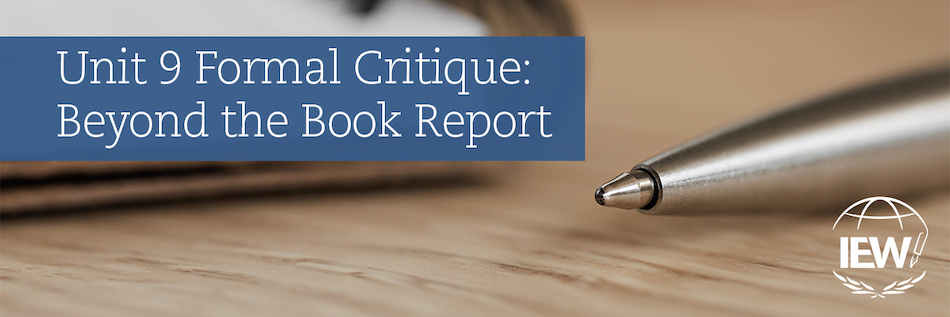
Have you ever met someone who remembers fondly doing book reports? Me either. Still, they are one of those tried and true assignments that teachers have given their students for decades. Opinions vary widely about whether they are worthwhile or possibly discourage a love of reading, yet many teachers still regularly assign some type of book report, particularly in the elementary grades. At issue is that traditional book reports don’t adequately provide students with the critical thinking skills or the specialized vocabulary they need to dig deeper into a book or to prepare them to analyze literature when they reach middle and high school. IEW® offers a reliable and effective structural model for book reports that provides both: the Unit 9 Formal Critique. Not only does it provide a better model, but it also becomes a runway step for writing Response to Literature and Literary Analysis essays.
The formal critique model requires students to combine elements of other units previously learned and practiced during the school year. The three body paragraphs follow the Unit 3 Story Sequence Chart to explain story details: the characters, the conflict/problem, and the climax/resolution. Like the Unit 8 Formal Essay model, in Unit 9 students are asked to think about a subject in a critical way to make judgments about it. In a critique, students are asked to make and defend judgments in a five-paragraph essay about a short story or book.
The introductory and concluding paragraphs practiced in Units 7 and 8 are modified for the critique model. The introduction provides basic information about the story, such as the title, author, setting, story type, and some background. In the conclusion, students give their opinion of the story and defend it. With young students this can be as simple as whether they enjoyed it or not and why, but as students move into upper elementary grades and middle school, they will need to dig deeper to make and support judgments about the characters, a theme, or an author’s style.
Before starting Unit 9, a quick review of Unit 3 is recommended. Because the body paragraphs  of the critique model comprise a summary of the story or book, teachers should model, and give their students time to practice, how to write “straight” summaries. A straight summary is written without changes or variations in the characters, setting, or the conflict. The first time students attempt a Unit 9 piece, we also recommend that teachers take some time to introduce the unit by revisiting the story used in the first lesson of Unit 3 in the Classroom Supplement (“The Boy Who Cried Wolf” in Level A, “The Lion and the Shepherd” in Level B, “The Little Mermaid” in Level C), or use “The Fox and the Crow” from the Teaching Writing: Structure and Style® Seminar Workbook. Together, the teacher and class write out the story sequence outline without changing the characters or setting. They are then prepared to begin learning the Unit 9 critique’s introduction and conclusion.
of the critique model comprise a summary of the story or book, teachers should model, and give their students time to practice, how to write “straight” summaries. A straight summary is written without changes or variations in the characters, setting, or the conflict. The first time students attempt a Unit 9 piece, we also recommend that teachers take some time to introduce the unit by revisiting the story used in the first lesson of Unit 3 in the Classroom Supplement (“The Boy Who Cried Wolf” in Level A, “The Lion and the Shepherd” in Level B, “The Little Mermaid” in Level C), or use “The Fox and the Crow” from the Teaching Writing: Structure and Style® Seminar Workbook. Together, the teacher and class write out the story sequence outline without changing the characters or setting. They are then prepared to begin learning the Unit 9 critique’s introduction and conclusion.
The critique model can also be used with nonfiction books and other sources by following the Unit 4 model format for the body paragraphs. (Refer to the model on page 149 of your Seminar Workbook.) Students choose three topics from the book or article and include five to seven interesting, important, or relevant details in a paragraph about each topic. In the introduction of a nonfiction critique, students include information about the book’s title, author, and publisher before they state the three topics they have written about. In the concluding paragraph, after restating their three topics, students can analyze the writing style or the interest or value of the information read. Just as they did in Units 4, 6, and 7, students tell what was most interesting (significant, for older students) and why in the concluding paragraph. Whether a fiction or nonfiction critique is written, students will make a recommendation about or an evaluation of the book. This calls upon the skills they have learned in Unit 8 in order to defend their points of view.
Once students are comfortable with the critique model and are beginning to use critique vocabulary appropriately and with greater confidence, they are ready to move on to Response to Literature essays in the intermediate grades and, in time, Literary Analysis essays in middle school and high school. For more information about the Response to Literature and Literary Analysis models, turn to the Writing about Literature tab in your Seminar Workbook. If you need a refresher of Unit 9 and Writing about Literature, view Disk 9 or streaming video Clip 9 in the Teaching Writing: Structure and Style Seminar.
The beauty of the Structure and Style method is that as students cycle through the nine units each year and move toward mastery of the system, they begin to see how they can synthesize all the skills they have learned for any type of writing assignment they may face. What a powerful tool to place in your students’ hands!
Our Schools Division Educational Consultants team is ready to answer any questions you have about IEW’s methods and materials. Give us a call at 800.856.5815, and we’ll connect you.
IEW and Structure and Style are registered trademarks of the Institute for Excellence in Writing, L.L.C.
|
Jean brings 34 years of classroom experience to IEW, having taught grades 1–6 in New York, Virginia, and in California, where she taught sixth-grade language arts in the Rocklin Unified School District. She was introduced to IEW in 2001 when a colleague shared Student Writing Intensive videos at weekly school staff meetings. As a result of student progress and teacher enthusiasm at her school, RUSD brought Andrew Pudewa to Rocklin many times over the next several years to train district teachers, resulting in improved student writing and test scores district-wide. Named Rocklin’s “Elementary Teacher of the Year” in 2001, Jean was also included in the 2004 and 2005 editions of Who’s Who Among America’s Teachers. |

